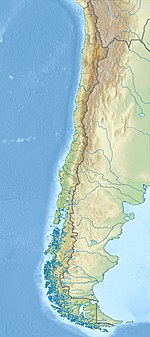1835 Concepción earthquake
| Date | February 20, 1835 |
|---|---|
| Magnitude | 8.2 Magnitude Mfa |
| Epicenter | 36°48′S 73°00′W / 36.8°S 73.0°WCoordinates: 36°48′S 73°00′W / 36.8°S 73.0°W |
| Areas affected | Chile |
| Tsunami | yes |
| Casualties | >50 |
The 1835 Concepción earthquake occurred near the neighboring cities of Concepción and Talcahuano in Chile on February 20 at 11:30 local time (15:30 UTC) and has an estimated magnitude of 8.2 Mfa or 8.1 Ml. The earthquake triggered a tsunami which caused the destruction of Talcahuano. A total of at least 50 people died from the effects of the earthquake and the tsunami. The earthquake caused damage from San Fernando in the north to Osorno in the south. It was felt over a still wider area from Copiapó in the north to the island of Chiloe in the south and as far west as the Juan Fernández Islands.
Chile lies above the convergent boundary between the Nazca Plate and the South American Plate, with a convergence rate of 66 mm/yr. This boundary has been the site of many historical megathrust earthquakes, including the largest earthquake ever recorded. The rupture area of the 1835 earthquake was noted as a prominent seismic gap, leading to a forecast of a large earthquake (Mw 8.0–8.5) within a few decades. The recent 2010 Chile earthquake appears to have ruptured this part of the plate interface.
Concepción was devastated, with most buildings being destroyed. A later survey found that 33% of kiln-dried brick buildings, 71% of mud-brick buildings and 95% of stone-built constructions were destroyed with all the rest being damaged. Despite this degree of damage only 50 people were reported dead. The low level of fatalities was attributed to the gradual increase in the intensity of shaking and that the earthquake occurred during the middle of the day, giving most of the inhabitants time to get clear. The destruction at Talcahuano was greater still due to the effects of the tsunami, which left only the lower parts of some buildings standing. A schooner was swept about 200 m inland, into the middle of the ruined town. There were few deaths, as the inhabitants had time to run up the hills behind the town.
...
Wikipedia


